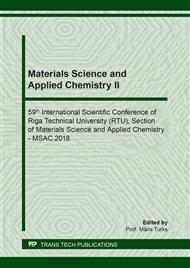[1]
F. Dimins, V. Mikelsone, P. Kuka, A.N. Jefremovs, Effect of different types of heat treatment on invertase in honey, FoodBalt 2014. (2014) 284-288.
Google Scholar
[2]
A. Aguilar-Reynosa, A. Romaní, R.Ma. Rodríguez-Jasso, C.N. Aguilar, G. Garrote, H.A. Ruiz, Microwave heating processing as alternative of pretreatment in second-generation biorefinery: An overview, Energy Conversion and Management. 136 (2017) 50-65.
DOI: 10.1016/j.enconman.2017.01.004
Google Scholar
[3]
D.V. Szabó, S. Schlabach, Microwave plasma synthesis of materials - from physics and chemistry to nanoparticles: A materials scientist's viewpoint, Inorganics. 2 (2014) 468-507.
DOI: 10.3390/inorganics2030468
Google Scholar
[4]
M. Vollmer, Physics of the microwave oven, Physics Education. 39(1) (2004) 74-81.
Google Scholar
[5]
K.D. Ashim, Handbook of microwave technology for food applications, New York - Basel, Marcel Dekker, Inc., 2001, 536.
Google Scholar
[6]
M.S. Venkatesh, G.S.V. Raghavan, An overview of microwave processing and dielectric properties of agri-food material, Biosystems Engineering. 88(1) (2004) 1-18.
DOI: 10.1016/j.biosystemseng.2004.01.007
Google Scholar
[7]
R.H. Garret, C.M. Grisham, Biochemistry, 4th Edition, Belmont, Brooks/Cole, Cengage Learning, 2010, 1183.
Google Scholar
[8]
H.D. Belitz, W. Grosch, P. Schieberle, Food Chemistry, Berlin, Heidelberg, Springer – Verlag, 2009, 1114.
Google Scholar
[9]
S. Bogdanov, Harmonised methods of the international honey commission. Retrieved July 18, 2016, from http://www.ihc-platform.net/ihcmethods2009.pdf (2009).
Google Scholar
[10]
K.B. Lichtenberg, Evidence for correlation between invertase activity and sucrose content during the ripening process of honey, Journal of Apicultural Research. 53(3) (2014) 364-373.
DOI: 10.3896/ibra.1.53.3.03
Google Scholar
[11]
K. Bartaskova, M. Drackova, I. Borkovcova, L. Vorlova, Impact of microwave heating on hydroxymethylfurfural content in Czech honeys, Czech Journal of Food Sciences. 29(4) (2011) 328-336.
DOI: 10.17221/110/2009-cjfs
Google Scholar
[12]
S. Kowalski, Changes of antioxidant activity and formation of 5-hydroxymethylfurfural in honey during thermal and microwave processing, Food Chemistry. 141(2) (2013) 1378-1382.
DOI: 10.1016/j.foodchem.2013.04.025
Google Scholar
[13]
L.S. Chua, N.A. Adnan, N.L. Abdul-Rahaman, M.R. Sarmidi, Effect of thermal treatment on the biochemical composition of tropical honey samples, International Food Research Journal. 21(2) (2014) 773-778.
Google Scholar
[14]
C.B. Fabíola, D.B. Fabiana, P.O. Gabriela, M.P. Lais, V.G. Luciano, C.O.C. Ana, 5-HMF and carbohydrates content in stingless bee honey by CE before and after thermal treatment. Food Chemistry. 159 (2014) 244-249.
DOI: 10.1016/j.foodchem.2014.03.016
Google Scholar
[15]
S. Bogdanov, P. Martin, C. Lüllmann, Harmonised methods of the European Honey Commission, Apidologie (Extra issue). (1997) 1-59.
Google Scholar
[16]
H.U. Hebbar, K.E. Nandini, M.Ch. Lakshmi, R. Subramanian, Microwave and infrared heat processing of honey and its quality, Food Science and Technology Research. 9 (2003) 49-53.
DOI: 10.3136/fstr.9.49
Google Scholar
[17]
P.K. Bath, N. Singh, Effect of microwave heating on hydroxymethylfurfural formation and browning in Helianthus annuus and Eucalyptus lanceolatus honey, Journal of Food Science and Technology-Mysore. 38 (2001) 366-368.
Google Scholar


